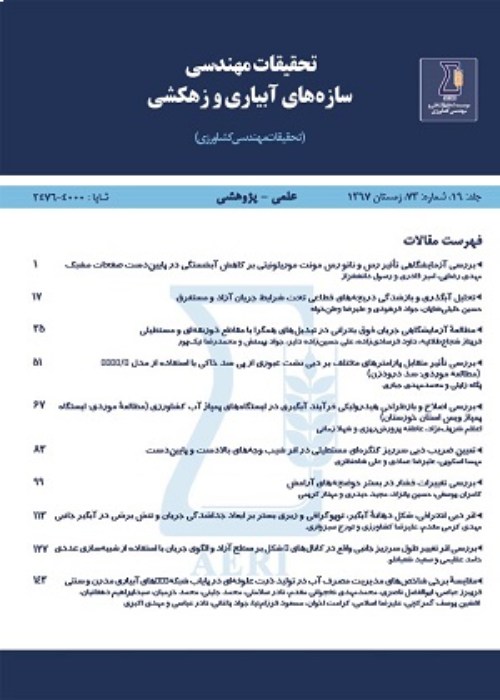Assessment of improving the accuracy of actual evapotranspiration estimation in agricultural lands using data assimilation with remote sensing observations and the FAO-56 model
Author(s):
Article Type:
Research/Original Article (دارای رتبه معتبر)
Abstract:
Introduction
Data assimilation is a scientific method which integrates information from the actual measurements and the model predictions within a defined framework to enhance the accuracy of the estimations of variables or parameters under investigation. This process comprises of two phases called prediction and update. In the prediction phase, the model estimations are computed using the Monte Carlo simulation method. This process continues until observation data (measurements) becomes available. In the update phase, model estimations and observations are combined, taking into account the confidence level associated with each one of the data sources (observations, and model estimations), resulting in posteriori estimates (updated outcomes). This study focuses on improving the accuracy of the estimates of the soil moisture contents at root zone depth using the ET estimation model suggested for non-standard conditions by FAO 56 (Allen et al., 1998) through the utilization of two data assimilation methods namely the Ensemble Kalman Filter (EnKF) and the Particle Filter (PF). ET was calculated according to the Surface Energy Balance (SEBAL) algorithm using Landsat 8 satellite imagery as observation data for the data assimilation system.Materials and Methods
In order to ascertain the effectiveness of the data assimilation methods applied, results obtained from a data assimilation system (referred to as BL) which was implemented in two sugar beet fields and two corn fields in the Jovein region were utilized. In the BL system, simulated soil moisture contents of the root zone layer obtained by numerically solving the Richards equation were combined with the soil moisture measurements taken at specific points in the fields using soil moisture sensors (TDR). 51 TDR access tubes were installed in the fields to measure soil moisture contents at various depths using Time Domain Reflectometry (TDR) sensors. Soil moisture measurements were recorded from Khordad to Aban 1399 (write in English calendar).The essence of data assimilation methods lies in the amalgamation of homogeneous information about the studied phenomenon obtained through different mechanisms. In this study, the observations utilized included ET calculated based on the SEBAL algorithm. In the FAO-56 model, evapotranspiration and soil moisture content of the surface and root zone layers were computed. Since soil moisture contents of the surface and the root zone layers serve as the initial conditions for subsequent simulation steps, data assimilation was applied to the soil moisture content instead of the ET. To achieve this, ET obtained from the SEBAL algorithm was converted into soil moisture content and subsequently used in the data assimilation process.Conclusion
The average standard deviation of the simulated soil moisture contents (σ) in the PF and EnKF approaches was 36% and 32% lower, respectively, compared to the open-loop (OL) approach. Throughout the growth period, PF and EnKF consistently resulted in lower σ compared to OL in the three fields which were irrigated by center-pivot irrigation systems. However, following each irrigation event in the field M, which was irrigated by a drip irrigation system, σ suddenly increased and became nearly equivalent to OL. This was attributed to the greater depth of irrigation water in this field as compared with the other three fields. On the average, the magnitude of σ change (σΔ), representing the reduction in σ before and after the update, was 0.032 and 0.037 for PF and EnKF, respectively. Consequently, the results suggested that data assimilation reduces the uncertainty of simulation results.The research findings indicate that data assimilation significantly reduced the BIAS and nRMSE indices compared with the OL approach. The average BIAS for EnKF, PF, and OL was 0.018, 0.020, and 0.028, respectively, while the average nRMSE for the three methods was 17.3%, 17.5%, and 18.9%, respectively. In other words, the use of ET observations obtained from Landsat 8 satellite imagery and the SEBAL algorithm significantly improved the accuracy of the estimation of ET with the FAO-56 model. Therefore, the obtained results suggest that data assimilation can be employed to enhance the accuracy water consumption estimates and to improve irrigation management.Keywords:
Language:
Persian
Published:
Irrigation and Drainage Structures Engineering Research, Volume:24 Issue: 92, 2024
Pages:
47 to 68
https://magiran.com/p2709888
دانلود و مطالعه متن این مقاله با یکی از روشهای زیر امکان پذیر است:
اشتراک شخصی
با عضویت و پرداخت آنلاین حق اشتراک یکساله به مبلغ 1,390,000ريال میتوانید 70 عنوان مطلب دانلود کنید!
اشتراک سازمانی
به کتابخانه دانشگاه یا محل کار خود پیشنهاد کنید تا اشتراک سازمانی این پایگاه را برای دسترسی نامحدود همه کاربران به متن مطالب تهیه نمایند!
توجه!
- حق عضویت دریافتی صرف حمایت از نشریات عضو و نگهداری، تکمیل و توسعه مگیران میشود.
- پرداخت حق اشتراک و دانلود مقالات اجازه بازنشر آن در سایر رسانههای چاپی و دیجیتال را به کاربر نمیدهد.
In order to view content subscription is required
Personal subscription
Subscribe magiran.com for 70 € euros via PayPal and download 70 articles during a year.
Organization subscription
Please contact us to subscribe your university or library for unlimited access!


